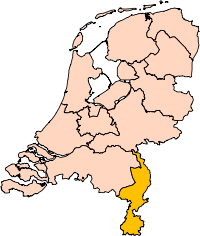Echt-Susteren
| Echt-Susteren Ech-Zöstere | |||
|---|---|---|---|
| Municipality | |||
|
Church in Nieuwstadt | |||
| |||
.svg.png) Location in Limburg | |||
| Coordinates: 51°6′N 5°52′E / 51.100°N 5.867°ECoordinates: 51°6′N 5°52′E / 51.100°N 5.867°E | |||
| Country | Netherlands | ||
| Province | Limburg | ||
| Established | 1 January 2003[1] | ||
| Government[2] | |||
| • Body | Municipal council | ||
| • Mayor | Jos Hessels (CDA) | ||
| Area[3] | |||
| • Total | 104.53 km2 (40.36 sq mi) | ||
| • Land | 103.11 km2 (39.81 sq mi) | ||
| • Water | 1.42 km2 (0.55 sq mi) | ||
| Elevation[4] | 30 m (100 ft) | ||
| Population (May 2014)[5] | |||
| • Total | 31,975 | ||
| • Density | 310/km2 (800/sq mi) | ||
| Time zone | CET (UTC+1) | ||
| • Summer (DST) | CEST (UTC+2) | ||
| Postcode | 6100–6118 | ||
| Area code | 046, 0475 | ||
| Website |
www | ||
Echt-Susteren (Dutch ![]() pronunciation ; Limburgish: Ech-Zöstere) is a municipality in the southeastern Netherlands. Echt-Susteren was created in 2003 by merging the former municipalities of Echt and Susteren.[6]
pronunciation ; Limburgish: Ech-Zöstere) is a municipality in the southeastern Netherlands. Echt-Susteren was created in 2003 by merging the former municipalities of Echt and Susteren.[6]
Susteren is situated in a Euregional area. In the west the municipality borders to Belgium and in the east to Germany. The narrowest is only 4.8 km wide. It is possible to walk from Germany to Belgium via Netherlands in under an hour. The area of Echt-Susteren is a green municipality also known as the green waist of Limburg.
Population centres
Aasterberg, Baakhoven, Berkelaar, Dieteren, Echt, Echterbosch, Gebroek, Heide, Hingen, Illikhoven, Kokkelert, Koningsbosch, Maria-Hoop, Nieuwstadt, Oevereind, Ophoven, Oud-Roosteren, Peij, Pepinusbrug, Roosteren, Schilberg, Sint Joost, Slek, Susteren, Visserweert.
Topography

Dutch Topographic map of the municipality of Echt-Susteren, June 2015
Echt
Echt is a former municipality. It received city rights in 1343.
Susteren
Susteren is a former municipality. It received city rights in 1276.
Maria-Hoop
Maria-Hoop is a small village in the neighbourhood of the hamlets Echterbosch and Putbroek and the village Koningsbosch. Originally named Diergaarde, the village's named was changed to Maria-Hoop in 1953, after the local church Moeder der H. Hoop.
Roosteren
The name of the village of Roosteren (population circa 1600, including Kokkelert and Oevereind) was derived from a combination of the Rode Beek (Red Brook) and the town of Suestra (Susteren) leading to the name Roosteren. The village has two 'castles', the Castle Ter Boch and the Castle Eyckholt and a number of Lord Manors. It is located in between the Meuse River (Maas River) and the Juliana Canal (Juliana Kanaal) with a small part of the village separated from the main population centre by the canal: Oud Roosteren (Old Roosteren). The main church is located in Roosteren whereas the cemetery is located near the site of the former church in Old Roosteren.
References
- ↑ "Gemeentelijke indeling op 1 januari 2003" [Municipal divisions on 1 January 2003]. cbs.nl (in Dutch). CBS. Retrieved 15 October 2013.
- ↑ "Burgemeester" [Mayor] (in Dutch). Gemeente Echt-Susteren. Retrieved 15 October 2013.
- ↑ "Kerncijfers wijken en buurten" [Key figures for neighbourhoods]. CBS Statline (in Dutch). CBS. 2 July 2013. Retrieved 12 March 2014.
- ↑ "Postcodetool for 6101CV". Actueel Hoogtebestand Nederland (in Dutch). Het Waterschapshuis. Retrieved 15 October 2013.
- ↑ "Bevolkingsontwikkeling; regio per maand" [Population growth; regions per month]. CBS Statline (in Dutch). CBS. 26 June 2014. Retrieved 24 July 2014.
- ↑ Ad van der Meer and Onno Boonstra, Repertorium van Nederlandse gemeenten, KNAW, 2006.
External links
 Media related to Echt-Susteren at Wikimedia Commons
Media related to Echt-Susteren at Wikimedia Commons- Official website
 |
Maasgouw | Roerdalen |  | |
| Maaseik (BE-VLI) / Meuse | |
Waldfeucht (DE-NW) | ||
| ||||
| | ||||
| Sittard-Geleen | Selfkant (DE-NW) |



